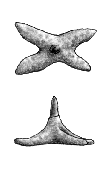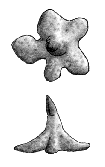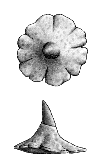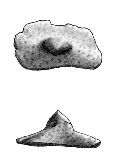EXTANT BATOIDS
Pelagic Stingray Dermal Denticles
Jim Bourdon, Scott Greenwald and Henry Mollet
Illustrated by Jim Bourdon, Copyright © 1997
The initial sampling in January, revealed a number of dermal denticles. It was decided at
that time to include denticles in the study. An attempt is currently under way to determine the
body location, sex association and shed rates for these denticles.
Using refined techniques, later samples produced many more denticles, as the March 14th lot
illustrates. These newer samples, contain many smaller denticles and increased the weekly count
substantially. The denticles have been separated into three groups (types D1-3) based on characteristics
of the basal plate (root) and crown.
Denticle Type "D1"
These are small denticles in which the base is branched and each
branch is not interconnected in the fashion that a duck's foot is "webbed". A single specimen
(57-G) had four "branches" (height: 0.7, width: 0.8 and depth: 1.2 mm. Four other denticles
(57-F) had five branches and were slightly larger (i.e., 0314-142 measured 1.0 x 1.1 x 1.1 mm).
The crowns on these denticles are circular.
Denticle Type "D2"
Denticles in this group are the most common and cover the broadest size range.
In this type, the number of branches are greatly increased (usually a dozen-or-so) and are
interconnected ("webbed") to varying degrees -- a complete basal plate with multiple basal ridges.
The illustrated examples 55-E and 55-F depict two variations of this design. In very small examples
(0.5 mm in depth), basal ridges are weak to non-existing (little or no branching). Eleven denticles
measuring 0.5 to 1.5 mm in depth and another eight, ranging from 1.6 to 2.7 mm, were in the March 14
sample. The enameloid crowns on these denticles are also circular.
The March 7th sample included two type D2 denticles that had fused basal plates (dual crowns). One was
joined on a lateral edge and the other, antero-posteriorly. This lot also included a D2 denticle which
measured 3.5 mm in depth and another that had a laterally compressed basal plate similar to 55-G.
Denticle Type "D3"
This group is based upon the shape of the crown which is antero-posteriorly
elongated and laterally compressed (?a hydrodynamic design). The basal plates have been noted
elongated, as depicted in illustration 55-G, or circular, as seen in 55-F (a type D2 denticle).
The March 14th sample produced six specimens ranging in depth from 1.7 to 3.0 mm. The illustrated
denticle (55-G from a January lot) measured 4.0 mm in depth, making it the largest denticle recovered
so far.
| NOTE: Denticles and thorns were originally illustrated at
various enlargements (7.0 - 20.0 X). Unlike the tooth illustrations, no attempt has been made to
provide digitized illustrations enlarged at similar percentages.
|
 |
 |
 |
 |
 |
"D1" -- 57-G
hgt = 0.7 mm |
"D1" -- 57-F
hgt = 0.9 mm |
"D2" -- 55-E
hgt = 1.7 mm |
"D2" -- 55-F
hgt = 2.0 mm |
"D3" -- 55-G
hgt = 1.5 mm |
Page revised June 7, 1997, last revised Jan. 16, 2005









